1999 DODGE RAM wiring
[x] Cancel search: wiringPage 925 of 1691
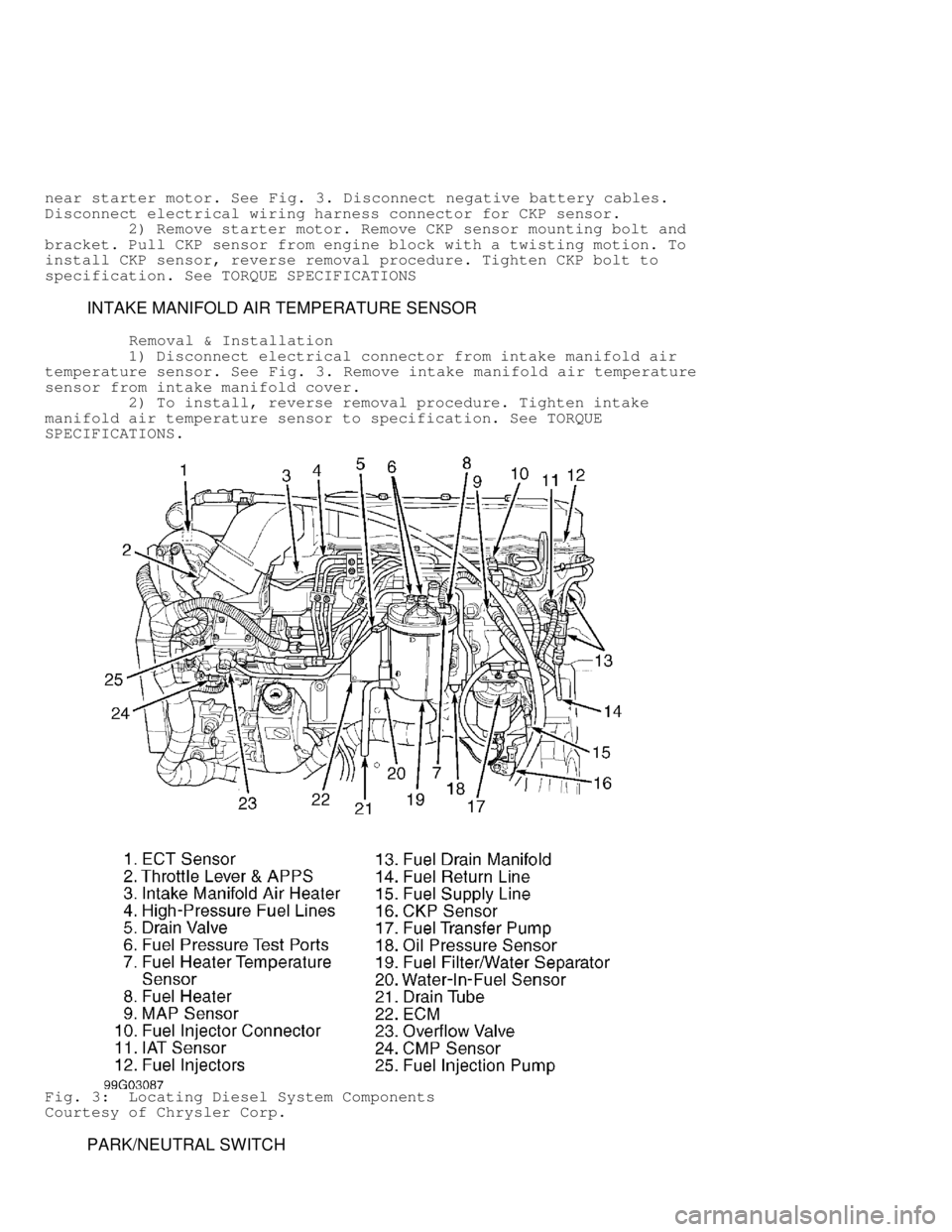
near starter motor. See Fig. 3. Disconnect negative battery cables.
Disconnect electrical wiring harness connector for CKP sensor.
2) Remove starter motor. Remove CKP sensor mounting bolt and
bracket. Pull CKP sensor from engine block with a twisting motion. To
install CKP sensor, reverse removal procedure. Tighten CKP bolt to
specification. See TORQUE SPECIFICATIONS
INTAKE MANIFOLD AIR TEMPERATURE SENSOR
Removal & Installation
1) Disconnect electrical connector from intake manifold air
temperature sensor. See Fig. 3. Remove intake manifold air temperature
sensor from intake manifold cover.
2) To install, reverse removal procedure. Tighten intake
manifold air temperature sensor to specification. See TORQUE
SPECIFICATIONS.
Fig. 3: Locating Diesel System Components
Courtesy of Chrysler Corp.
PARK/NEUTRAL SWITCH
Page 927 of 1691
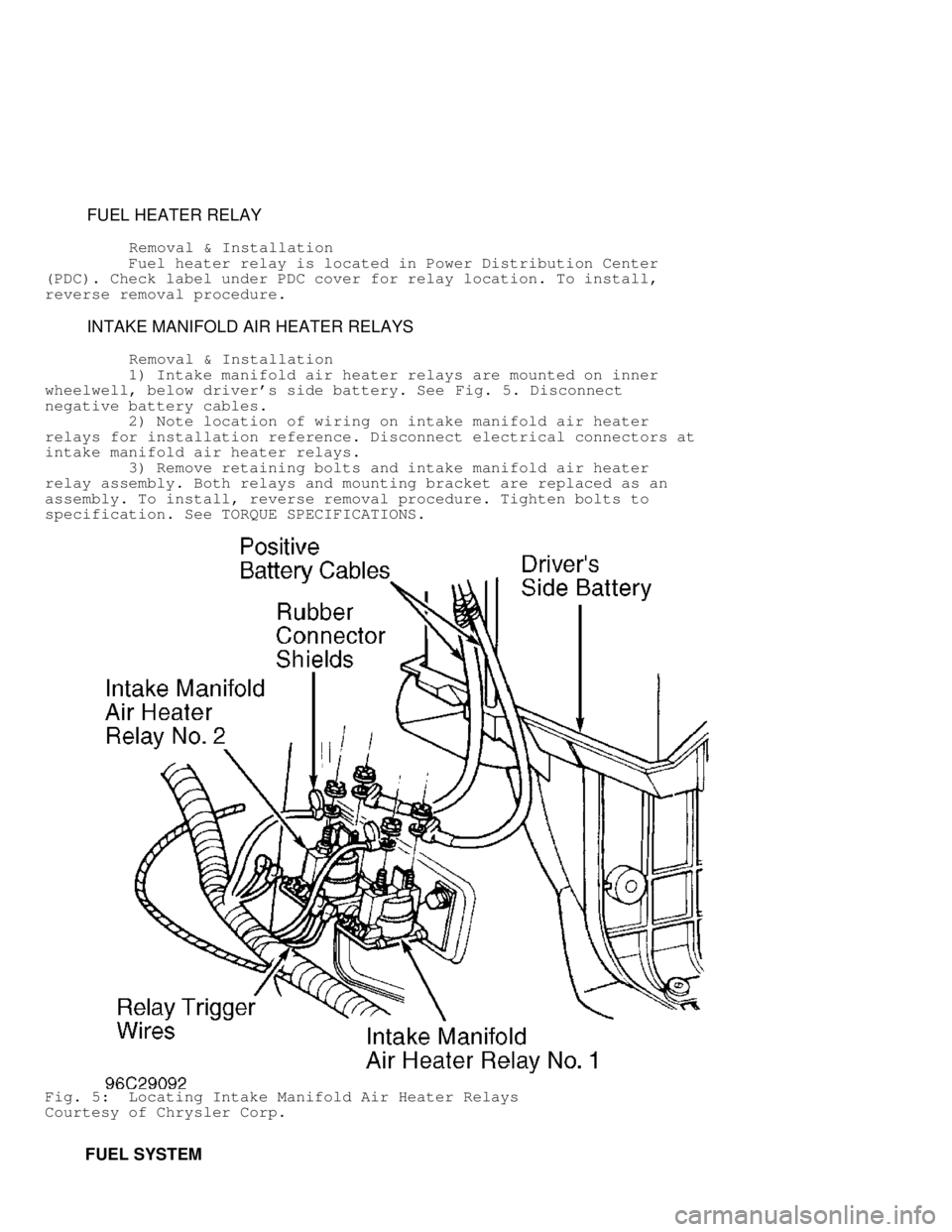
FUEL HEATER RELAY
Removal & Installation
Fuel heater relay is located in Power Distribution Center
(PDC). Check label under PDC cover for relay location. To install,
reverse removal procedure.
INTAKE MANIFOLD AIR HEATER RELAYS
Removal & Installation
1) Intake manifold air heater relays are mounted on inner
wheelwell, below driver's side battery. See Fig. 5. Disconnect
negative battery cables.
2) Note location of wiring on intake manifold air heater
relays for installation reference. Disconnect electrical connectors at
intake manifold air heater relays.
3) Remove retaining bolts and intake manifold air heater
relay assembly. Both relays and mounting bracket are replaced as an
assembly. To install, reverse removal procedure. Tighten bolts to
specification. See TORQUE SPECIFICATIONS.
Fig. 5: Locating Intake Manifold Air Heater Relays
Courtesy of Chrysler Corp.
FUEL SYSTEM
Page 931 of 1691
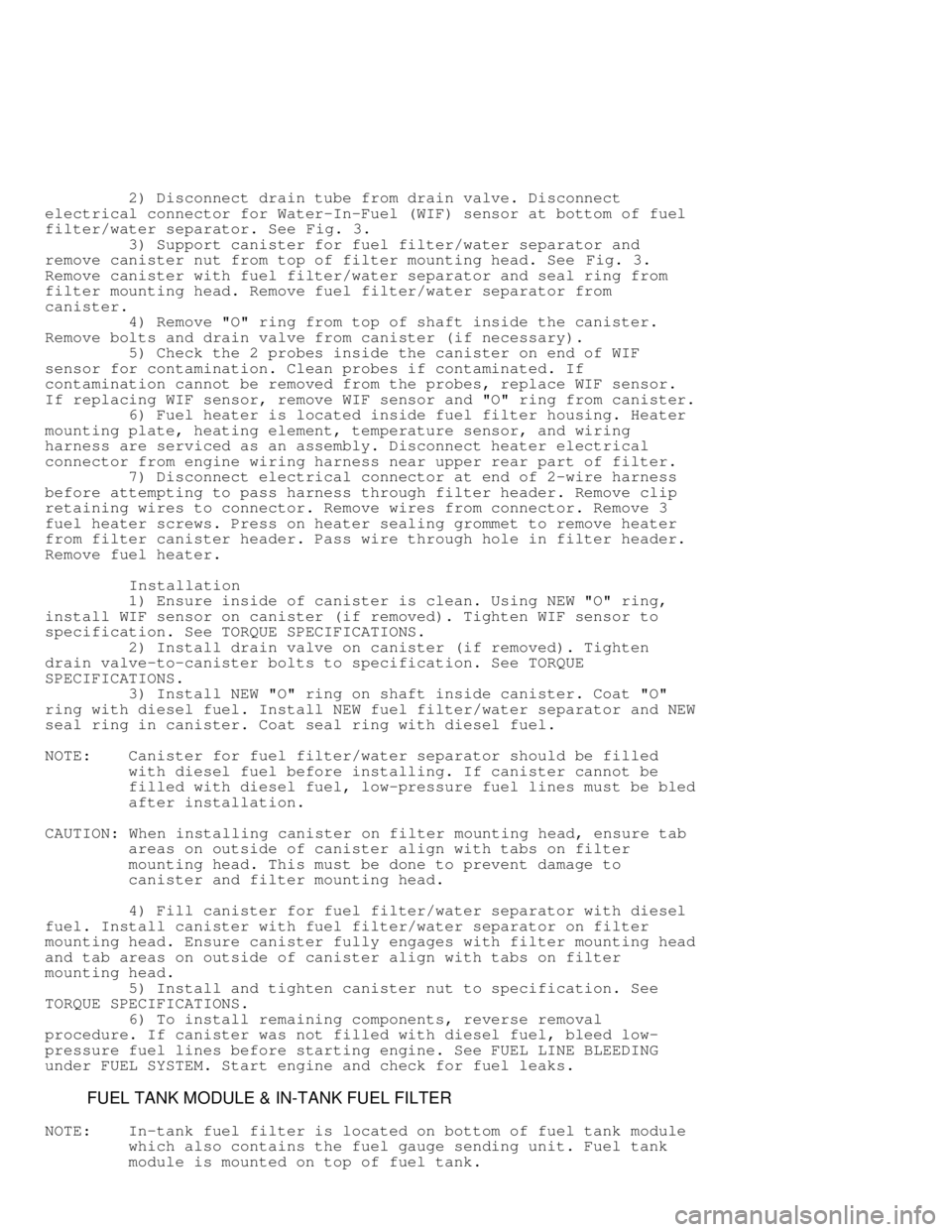
2) Disconnect drain tube from drain valve. Disconnect
electrical connector for Water-In-Fuel (WIF) sensor at bottom of fuel
filter/water separator. See Fig. 3.
3) Support canister for fuel filter/water separator and
remove canister nut from top of filter mounting head. See Fig. 3.
Remove canister with fuel filter/water separator and seal ring from
filter mounting head. Remove fuel filter/water separator from
canister.
4) Remove "O" ring from top of shaft inside the canister.
Remove bolts and drain valve from canister (if necessary).
5) Check the 2 probes inside the canister on end of WIF
sensor for contamination. Clean probes if contaminated. If
contamination cannot be removed from the probes, replace WIF sensor.
If replacing WIF sensor, remove WIF sensor and "O" ring from canister.
6) Fuel heater is located inside fuel filter housing. Heater
mounting plate, heating element, temperature sensor, and wiring
harness are serviced as an assembly. Disconnect heater electrical
connector from engine wiring harness near upper rear part of filter.
7) Disconnect electrical connector at end of 2-wire harness
before attempting to pass harness through filter header. Remove clip
retaining wires to connector. Remove wires from connector. Remove 3
fuel heater screws. Press on heater sealing grommet to remove heater
from filter canister header. Pass wire through hole in filter header.
Remove fuel heater.
Installation
1) Ensure inside of canister is clean. Using NEW "O" ring,
install WIF sensor on canister (if removed). Tighten WIF sensor to
specification. See TORQUE SPECIFICATIONS.
2) Install drain valve on canister (if removed). Tighten
drain valve-to-canister bolts to specification. See TORQUE
SPECIFICATIONS.
3) Install NEW "O" ring on shaft inside canister. Coat "O"
ring with diesel fuel. Install NEW fuel filter/water separator and NEW
seal ring in canister. Coat seal ring with diesel fuel.
NOTE: Canister for fuel filter/water separator should be filled
with diesel fuel before installing. If canister cannot be
filled with diesel fuel, low-pressure fuel lines must be bled
after installation.
CAUTION: When installing canister on filter mounting head, ensure tab
areas on outside of canister align with tabs on filter
mounting head. This must be done to prevent damage to
canister and filter mounting head.
4) Fill canister for fuel filter/water separator with diesel
fuel. Install canister with fuel filter/water separator on filter
mounting head. Ensure canister fully engages with filter mounting head
and tab areas on outside of canister align with tabs on filter
mounting head.
5) Install and tighten canister nut to specification. See
TORQUE SPECIFICATIONS.
6) To install remaining components, reverse removal
procedure. If canister was not filled with diesel fuel, bleed low-
pressure fuel lines before starting engine. See FUEL LINE BLEEDING
under FUEL SYSTEM. Start engine and check for fuel leaks.
FUEL TANK MODULE & IN-TANK FUEL FILTER
NOTE: In-tank fuel filter is located on bottom of fuel tank module
which also contains the fuel gauge sending unit. Fuel tank
module is mounted on top of fuel tank.
Page 934 of 1691
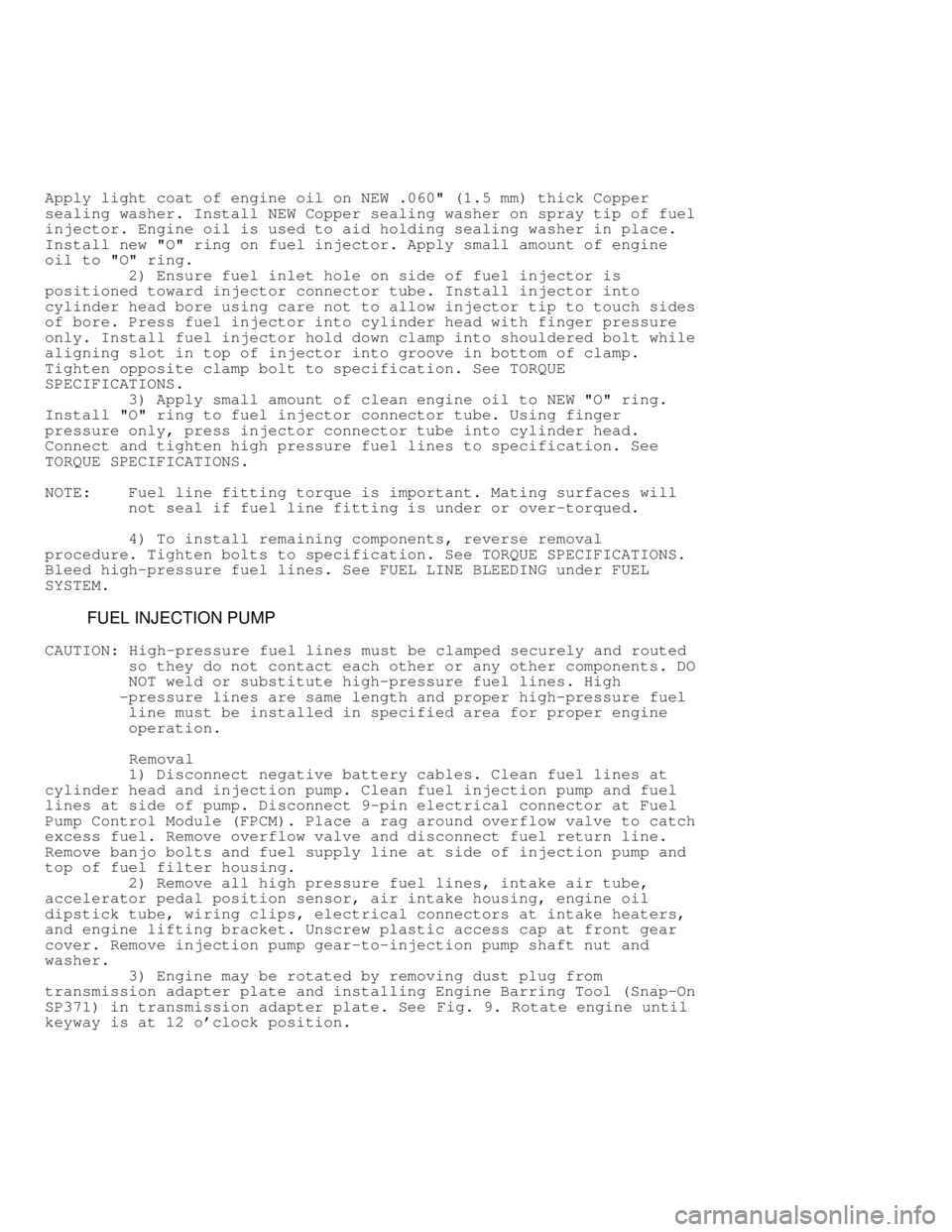
Apply light coat of engine oil on NEW .060" (1.5 mm) thick Copper
sealing washer. Install NEW Copper sealing washer on spray tip of fuel
injector. Engine oil is used to aid holding sealing washer in place.
Install new "O" ring on fuel injector. Apply small amount of engine
oil to "O" ring.
2) Ensure fuel inlet hole on side of fuel injector is
positioned toward injector connector tube. Install injector into
cylinder head bore using care not to allow injector tip to touch sides
of bore. Press fuel injector into cylinder head with finger pressure
only. Install fuel injector hold down clamp into shouldered bolt while
aligning slot in top of injector into groove in bottom of clamp.
Tighten opposite clamp bolt to specification. See TORQUE
SPECIFICATIONS.
3) Apply small amount of clean engine oil to NEW "O" ring.
Install "O" ring to fuel injector connector tube. Using finger
pressure only, press injector connector tube into cylinder head.
Connect and tighten high pressure fuel lines to specification. See
TORQUE SPECIFICATIONS.
NOTE: Fuel line fitting torque is important. Mating surfaces will
not seal if fuel line fitting is under or over-torqued.
4) To install remaining components, reverse removal
procedure. Tighten bolts to specification. See TORQUE SPECIFICATIONS.
Bleed high-pressure fuel lines. See FUEL LINE BLEEDING under FUEL
SYSTEM.
FUEL INJECTION PUMP
CAUTION: High-pressure fuel lines must be clamped securely and routed
so they do not contact each other or any other components. DO
NOT weld or substitute high-pressure fuel lines. High
-pressure lines are same length and proper high-pressure fuel
line must be installed in specified area for proper engine
operation.
Removal
1) Disconnect negative battery cables. Clean fuel lines at
cylinder head and injection pump. Clean fuel injection pump and fuel
lines at side of pump. Disconnect 9-pin electrical connector at Fuel
Pump Control Module (FPCM). Place a rag around overflow valve to catch\
excess fuel. Remove overflow valve and disconnect fuel return line.
Remove banjo bolts and fuel supply line at side of injection pump and
top of fuel filter housing.
2) Remove all high pressure fuel lines, intake air tube,
accelerator pedal position sensor, air intake housing, engine oil
dipstick tube, wiring clips, electrical connectors at intake heaters,
and engine lifting bracket. Unscrew plastic access cap at front gear
cover. Remove injection pump gear-to-injection pump shaft nut and
washer.
3) Engine may be rotated by removing dust plug from
transmission adapter plate and installing Engine Barring Tool (Snap-On
SP371) in transmission adapter plate. See Fig. 9. Rotate engine until
keyway is at 12 o'clock position.
Page 939 of 1691
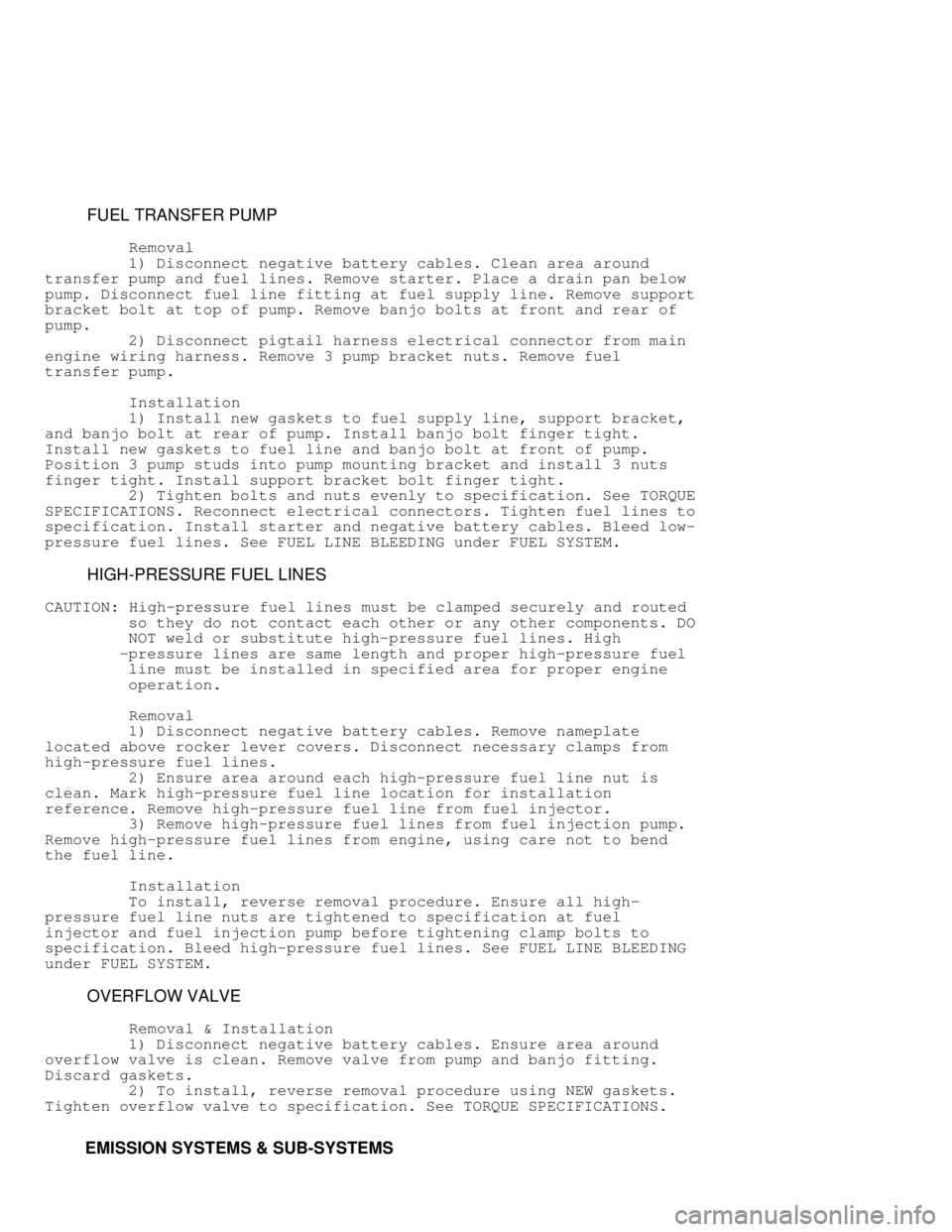
FUEL TRANSFER PUMP
Removal
1) Disconnect negative battery cables. Clean area around
transfer pump and fuel lines. Remove starter. Place a drain pan below
pump. Disconnect fuel line fitting at fuel supply line. Remove support
bracket bolt at top of pump. Remove banjo bolts at front and rear of
pump.
2) Disconnect pigtail harness electrical connector from main
engine wiring harness. Remove 3 pump bracket nuts. Remove fuel
transfer pump.
Installation
1) Install new gaskets to fuel supply line, support bracket,
and banjo bolt at rear of pump. Install banjo bolt finger tight.
Install new gaskets to fuel line and banjo bolt at front of pump.
Position 3 pump studs into pump mounting bracket and install 3 nuts
finger tight. Install support bracket bolt finger tight.
2) Tighten bolts and nuts evenly to specification. See TORQUE
SPECIFICATIONS. Reconnect electrical connectors. Tighten fuel lines to
specification. Install starter and negative battery cables. Bleed low-
pressure fuel lines. See FUEL LINE BLEEDING under FUEL SYSTEM.
HIGH-PRESSURE FUEL LINES
CAUTION: High-pressure fuel lines must be clamped securely and routed
so they do not contact each other or any other components. DO
NOT weld or substitute high-pressure fuel lines. High
-pressure lines are same length and proper high-pressure fuel
line must be installed in specified area for proper engine
operation.
Removal
1) Disconnect negative battery cables. Remove nameplate
located above rocker lever covers. Disconnect necessary clamps from
high-pressure fuel lines.
2) Ensure area around each high-pressure fuel line nut is
clean. Mark high-pressure fuel line location for installation
reference. Remove high-pressure fuel line from fuel injector.
3) Remove high-pressure fuel lines from fuel injection pump.
Remove high-pressure fuel lines from engine, using care not to bend
the fuel line.
Installation
To install, reverse removal procedure. Ensure all high-
pressure fuel line nuts are tightened to specification at fuel
injector and fuel injection pump before tightening clamp bolts to
specification. Bleed high-pressure fuel lines. See FUEL LINE BLEEDING
under FUEL SYSTEM.
OVERFLOW VALVE
Removal & Installation
1) Disconnect negative battery cables. Ensure area around
overflow valve is clean. Remove valve from pump and banjo fitting.
Discard gaskets.
2) To install, reverse removal procedure using NEW gaskets.
Tighten overflow valve to specification. See TORQUE SPECIFICATIONS.
EMISSION SYSTEMS & SUB-SYSTEMS
Page 957 of 1691
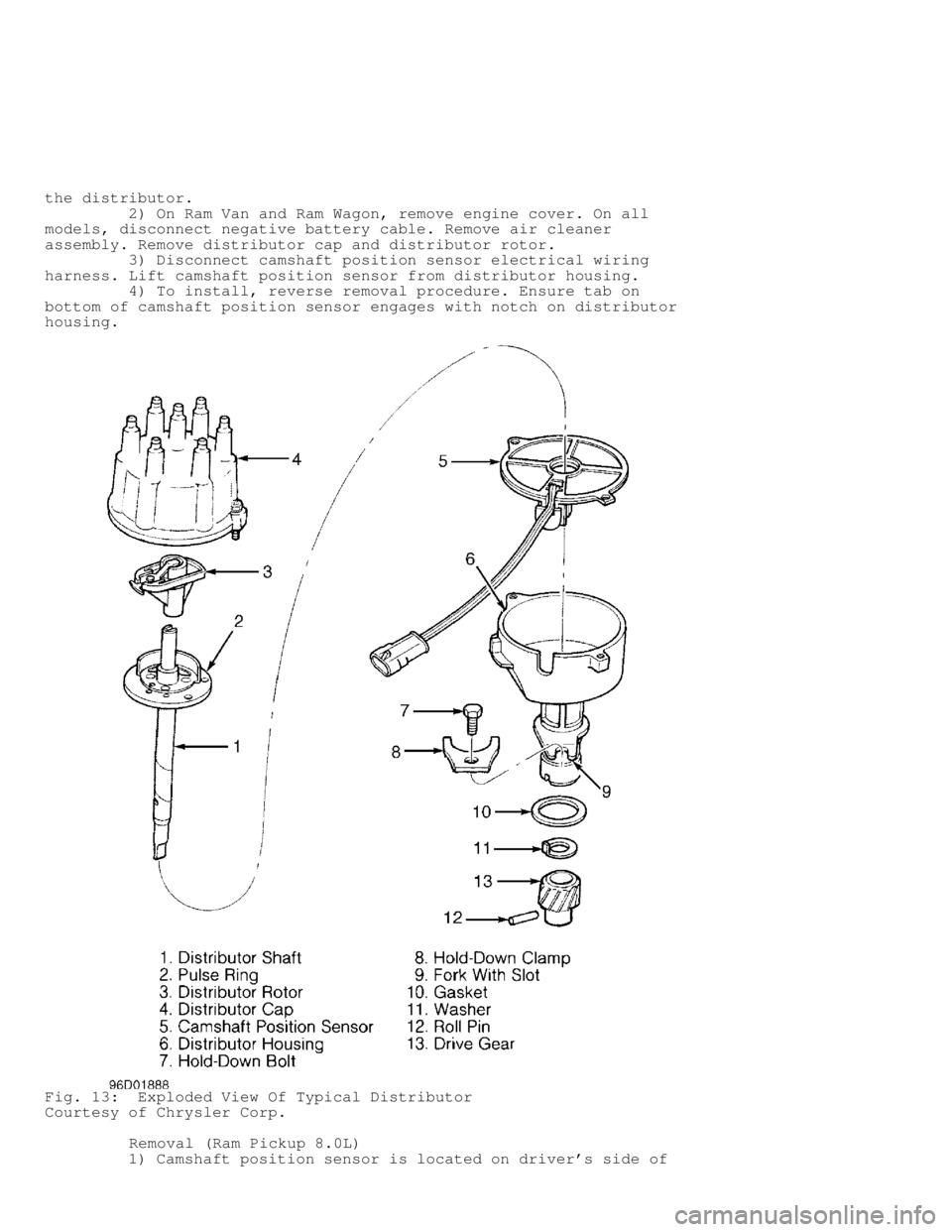
the distributor.
2) On Ram Van and Ram Wagon, remove engine cover. On all
models, disconnect negative battery cable. Remove air cleaner
assembly. Remove distributor cap and distributor rotor.
3) Disconnect camshaft position sensor electrical wiring
harness. Lift camshaft position sensor from distributor housing.
4) To install, reverse removal procedure. Ensure tab on
bottom of camshaft position sensor engages with notch on distributor
housing.
Fig. 13: Exploded View Of Typical Distributor
Courtesy of Chrysler Corp.
Removal (Ram Pickup 8.0L)
1) Camshaft position sensor is located on driver's side of
Page 962 of 1691
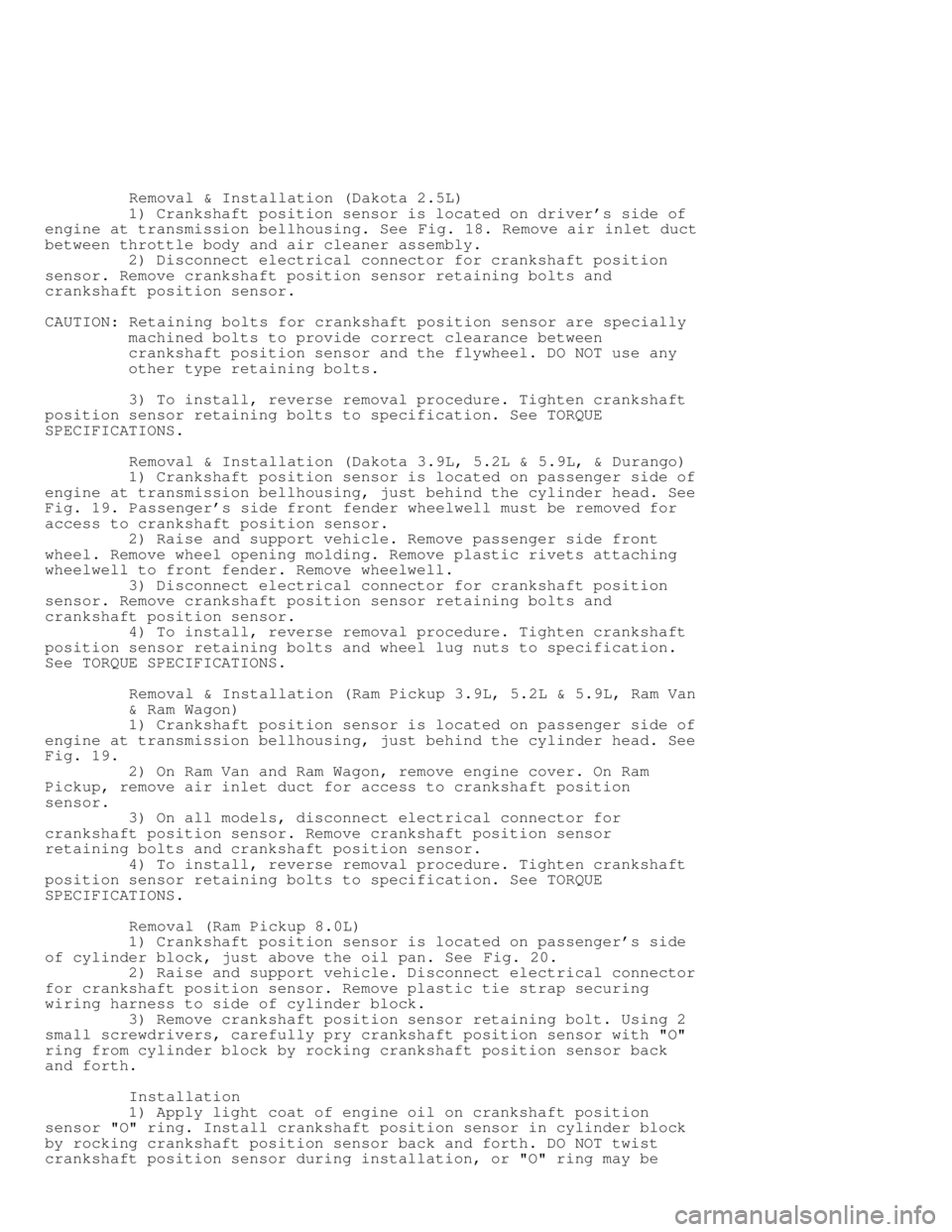
Removal & Installation (Dakota 2.5L)
1) Crankshaft position sensor is located on driver's side of
engine at transmission bellhousing. See Fig. 18. Remove air inlet duct
between throttle body and air cleaner assembly.
2) Disconnect electrical connector for crankshaft position
sensor. Remove crankshaft position sensor retaining bolts and
crankshaft position sensor.
CAUTION: Retaining bolts for crankshaft position sensor are specially
machined bolts to provide correct clearance between
crankshaft position sensor and the flywheel. DO NOT use any
other type retaining bolts.
3) To install, reverse removal procedure. Tighten crankshaft
position sensor retaining bolts to specification. See TORQUE
SPECIFICATIONS.
Removal & Installation (Dakota 3.9L, 5.2L & 5.9L, & Durango)
1) Crankshaft position sensor is located on passenger side of
engine at transmission bellhousing, just behind the cylinder head. See
Fig. 19 . Passenger's side front fender wheelwell must be removed for
access to crankshaft position sensor.
2) Raise and support vehicle. Remove passenger side front
wheel. Remove wheel opening molding. Remove plastic rivets attaching
wheelwell to front fender. Remove wheelwell.
3) Disconnect electrical connector for crankshaft position
sensor. Remove crankshaft position sensor retaining bolts and
crankshaft position sensor.
4) To install, reverse removal procedure. Tighten crankshaft
position sensor retaining bolts and wheel lug nuts to specification.
See TORQUE SPECIFICATIONS.
Removal & Installation (Ram Pickup 3.9L, 5.2L & 5.9L, Ram Van
& Ram Wagon)
1) Crankshaft position sensor is located on passenger side of
engine at transmission bellhousing, just behind the cylinder head. See
Fig. 19 .
2) On Ram Van and Ram Wagon, remove engine cover. On Ram
Pickup, remove air inlet duct for access to crankshaft position
sensor.
3) On all models, disconnect electrical connector for
crankshaft position sensor. Remove crankshaft position sensor
retaining bolts and crankshaft position sensor.
4) To install, reverse removal procedure. Tighten crankshaft
position sensor retaining bolts to specification. See TORQUE
SPECIFICATIONS.
Removal (Ram Pickup 8.0L)
1) Crankshaft position sensor is located on passenger's side
of cylinder block, just above the oil pan. See Fig. 20.
2) Raise and support vehicle. Disconnect electrical connector
for crankshaft position sensor. Remove plastic tie strap securing
wiring harness to side of cylinder block.
3) Remove crankshaft position sensor retaining bolt. Using 2
small screwdrivers, carefully pry crankshaft position sensor with "O"
ring from cylinder block by rocking crankshaft position sensor back
and forth.
Installation
1) Apply light coat of engine oil on crankshaft position
sensor "O" ring. Install crankshaft position sensor in cylinder block
by rocking crankshaft position sensor back and forth. DO NOT twist
crankshaft position sensor during installation, or "O" ring may be
Page 963 of 1691
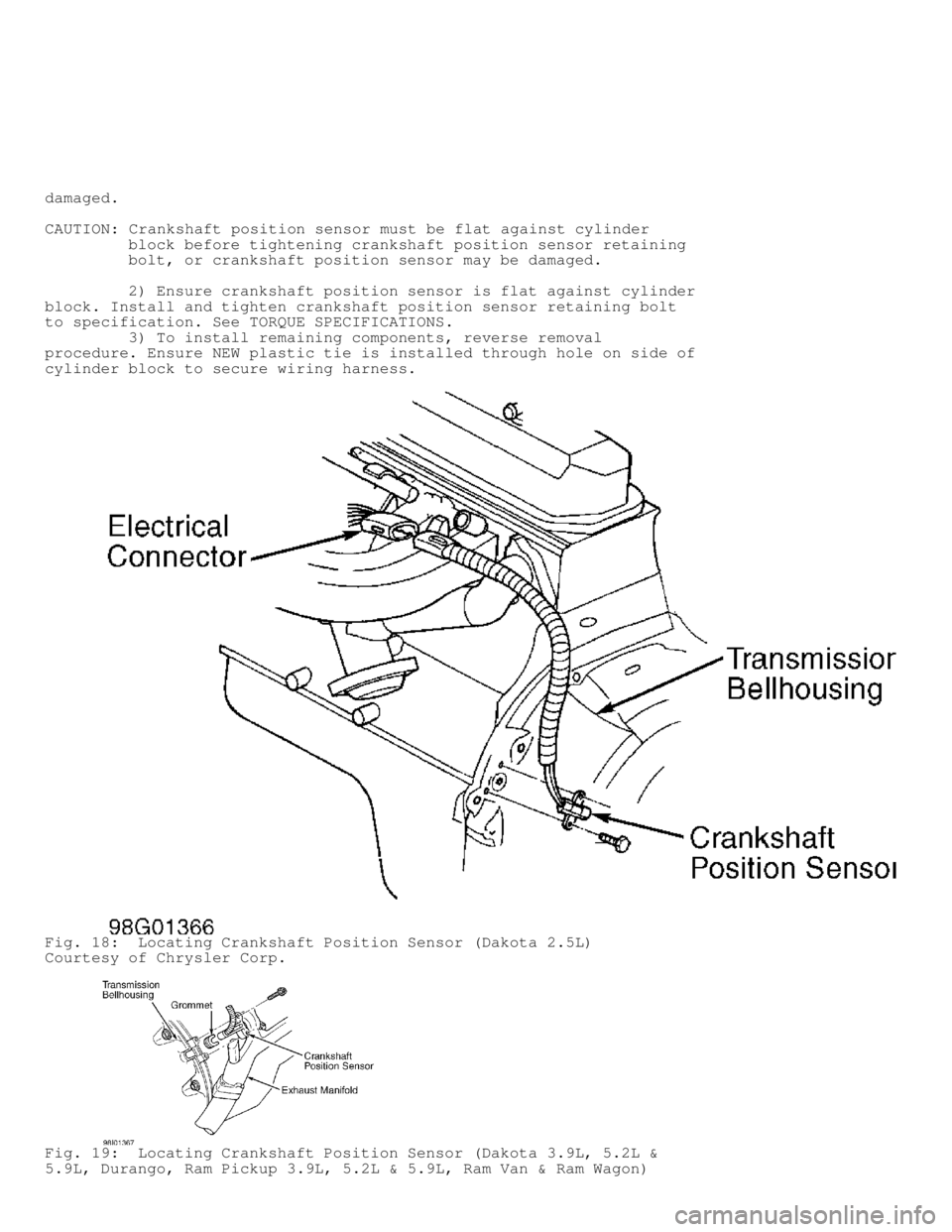
damaged.
CAUTION: Crankshaft position sensor must be flat against cylinder
block before tightening crankshaft position sensor retaining
bolt, or crankshaft position sensor may be damaged.
2) Ensure crankshaft position sensor is flat against cylinder
block. Install and tighten crankshaft position sensor retaining bolt
to specification. See TORQUE SPECIFICATIONS.
3) To install remaining components, reverse removal
procedure. Ensure NEW plastic tie is installed through hole on side of
cylinder block to secure wiring harness.
Fig. 18: Locating Crankshaft Position Sensor (Dakota 2.5L)
Courtesy of Chrysler Corp.
Fig. 19: Locating Crankshaft Position Sensor (Dakota 3.9L, 5.2L &
5.9L, Durango, Ram Pickup 3.9L, 5.2L & 5.9L, Ram Van & Ram Wagon)